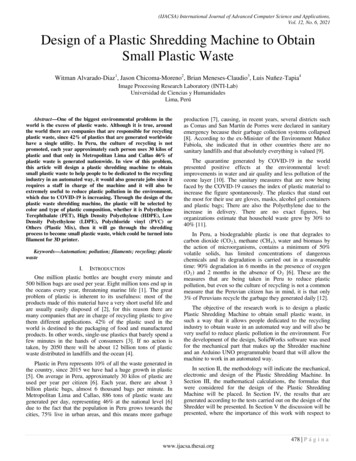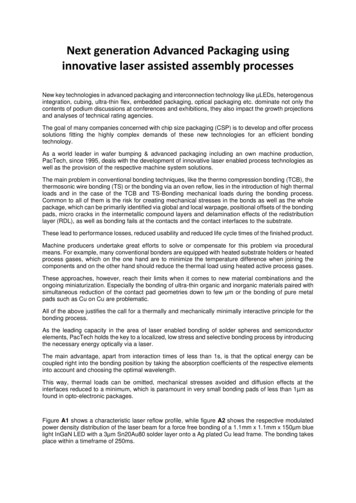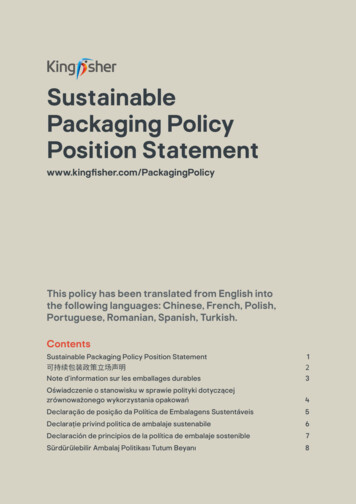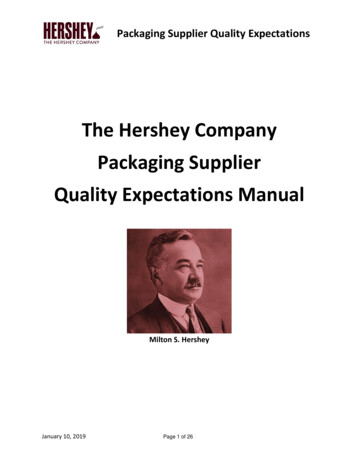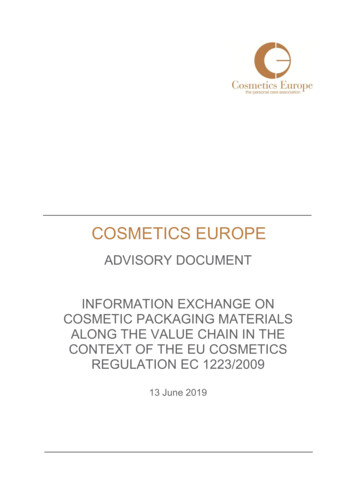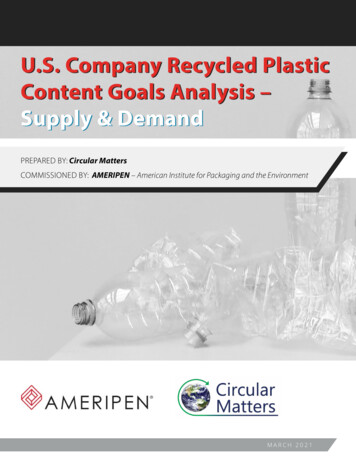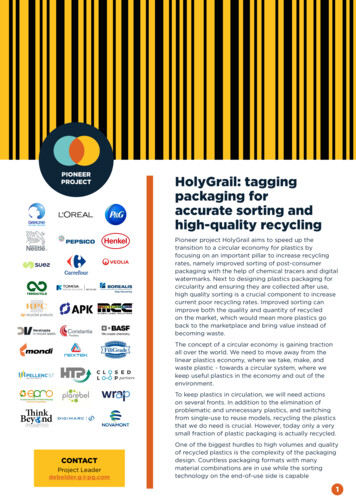
Transcription
661 Plastic Packaging Systems and Their Materials of ConstructionType of PostingPosting DateOfficial DateExpert CommitteeReason for RevisionRevision Bulletin, Postponement128 Apr 2017, revised 26-May-201701–May–2017General Chapters—Packaging and DistributionComplianceIn accordance with the Rules and Procedures of the 2015-2020 Council of Experts, the GeneralChapters—Packaging and Distribution Expert Committee has revised General Chapter 661 PlasticPackaging Systems and Their Materials of Construction.The purpose of the revisions will be to provide a three-year period for implementation of the requirementsspecified in General Chapters 661.1 and 661.2 , which otherwise will become applicable on May 1,2017 through General Chapter 659 ; to reinstate requirements previously expressed in General Chapter 661 during this three-year period; to enable early adoption of the requirements in General Chapters 661.1 and 661.2 at any time during the three-year period in lieu of meeting the reinstated 661 requirements; and to remove the exemption to General Chapters 661.1 and 661.2 for previouslyapproved plastic materials and packaging systems.The specific revisions are as follows: Delay until May 1, 2020 the implementation of new requirements of General Chapters 661.1 and 661.2 as currently specified in General Chapter 659 . Incorporate into General Chapter 661 the requirements previously specified in the USP 38 NF33 version of General Chapter 661 . Reference General Chapter 661 in General Chapter 659 to make these previous requirements applicable until May 1, 2020. Clarify in General Chapter 659 that early adoption of the requirements of 661.1 and 661.2 is permitted by USP, and that packaging systems in compliance with these requirements inadvance of May 1, 2020 will no longer need to comply with the reinstated 661 requirements tobe considered by USP to be in conformance with the USP–NF. Remove the current exemption to General Chapters 661.1 and 661.2 for plastic materialsand packaging systems previously approved by a regulatory authority.The 661 Plastic Packaging Systems and Their Materials of Construction Revision Bulletin willsupersede the monograph becoming official in USP 40–NF 35. The Revision Bulletin will be incorporatedin USP 41–NF 36.Should you have any questions, please contact Desmond Hunt, Ph.D. (301-816-8341 or dgh@usp.org).1The text of the notice was revised May 17, 2017 to clarify that the exemption is being removed from bothchapters 661.1 and 661.2 C188588-M99420-GCPD2015, Rev. 1 20170526
Revision BulletinOfficial May 1, 2017á661ñ 1á661ñ PLASTIC PACKAGING SYSTEMS AND THEIR MATERIALS OFCONSTRUCTIONAdd the following:(If the option of early adoption of Plastic Materials of Construction á661.1ñ and Plastic Packaging Systems for Pharmaceutical Use á661.2ñ is not used prior to May 1, 2020, the requirements under this chapter will apply.) (RB 1-May-2017)Add the following:INTRODUCTIONIt is the purpose of this chapter to provide standards for plastic materials and components used to package medical articles(pharmaceuticals, biologics, dietary supplements, and devices). Definitions that apply to this chapter are provided in Packagingand Storage Requirements á659ñ. Standards and tests for the functional properties of containers and their components are provided in Containers—Performance Testing á671ñ.In addition to the standards provided herein, the ingredients added to the polymers, and those used in the fabrication of thecontainers, must conform to the requirements in the applicable sections of the Code of Federal Regulations, Title 21, IndirectFood Additives, or have been evaluated by the FDA and determined to be acceptable substances for the listed use.Plastic articles are identified and characterized by IR spectroscopy and differential scanning calorimetry. Standards are provided in this chapter for the identification and characterization of the different types of plastic, and the test procedures are provided at the end of the chapter. The degree of testing is based on whether or not the container has direct contact with the drugproduct, and the risk is based on the route of administration.Plastics are composed of a mixture of homologous polymers, having a range of molecular weights. Plastics may contain other substances such as residues from the polymerization process, plasticizers, stabilizers, antioxidants, pigments, and lubricants.These materials meet the requirements for food contact as provided in the Code of Federal Regulations, Title 21. Factors such asplastic composition, processing and cleaning procedures, surface treatment, contacting media, inks, adhesives, absorption andpermeability of preservatives, and conditions of storage may also affect the suitability of a plastic for a specific use. Extractiontests are designed to characterize the extracted components and identify possible migrants. The degree or extent of testing forextractables of the component is dependent on the intended use and the degree of risk to adversely impact the efficacy of thecompendial article (drug, biologic, dietary supplement, or device). Resin-specific extraction tests are provided in this chapterfor polyethylene, polypropylene, polyethylene terephthalate, and polyethylene terephthalate G. Test all other plastics as directed for Test Methods, Physicochemical Tests. Conduct the Buffering Capacity test only when the containers are intended to holda liquid product.Plastic components used for products of high risk, such as those intended for inhalation, parenteral preparation, and ophthalmics, are tested using Test Methods, Biological Tests.Plastic containers intended for packaging products prepared for parenteral use meet the requirements for Test Methods, Biological Tests and Physicochemical Tests. Standards are also provided for polyethylene containers used to package dry oral dosage forms that are not meant for constitution into solution.POLYETHYLENE CONTAINERSScopeThe standards and tests provided in this section characterize containers and components, produced from either low-densitypolyethylene or high-density polyethylene of either homopolymer or copolymer resins that are interchangeably suitable forpackaging dry oral dosage forms not meant for constitution into solution. All polyethylene components are subject to testingby IR spectroscopy and differential scanning calorimetry. Where stability studies have been performed to establish the expiration date of a particular dosage form in the appropriate polyethylene container, then any other polyethylene container meeting these requirements may be similarly used to package such a dosage form, provided that the appropriate stability programsare expanded to include the alternative container, in order to ensure that the identity, strength, quality, and purity of the dosage form are maintained throughout the expiration period.BackgroundHigh-density and low-density polyethylene are long-chain polymers synthesized under controlled conditions of heat andpressure, with the aid of catalysts from not less than 85.0% ethylene and not less than 95.0% total olefins. Other olefin ingredients that are most frequently used are butene, hexene, and propylene. High-density polyethylene and low-density polyethy-C188588-M99420-GCPD2015, Rev. 1 20170526 2017 The United States Pharmacopeial Convention All Rights Reserved.
Revision BulletinOfficial May 1, 20172 á661ñlene both have an IR absorption spectrum that is distinctive for polyethylene, and each possesses characteristic thermal properties. High-density polyethylene has a density between 0.941 and 0.965 g per cm3. Low-density polyethylene has a density between 0.850 and 0.940 g per cm3. Other properties that may affect the suitability of polyethylene include modulus of elasticity, melt index, environmental stress crack resistance, and degree of crystallinity after molding.High-Density PolyethyleneInfrared Spectroscopy—Proceed as directed for Test Methods, Multiple Internal Reflectance. The corrected spectrum of thespecimen exhibits major absorption bands only at the same wavelengths as the spectrum of USP High-Density PolyethyleneRS.Differential Scanning Calorimetry—Proceed as directed for Test Methods, Thermal Analysis. The thermogram of the specimen is similar to the thermogram of USP High-Density Polyethylene RS, similarly determined, and the temperature of the endotherm (melt) in the thermogram of the specimen does not differ from that of the USP Reference Standard by more than6.0 .Heavy Metals and Nonvolatile Residue—Prepare extracts of specimens for these tests as directed for Test Methods, Physicochemical Tests, except that for each 20.0 mL of Extracting Medium the portion shall be 60 cm2, regardless of thickness.HEAVY METALS—Containers meet the requirements for Test Methods, Physicochemical Tests, Heavy Metals.NONVOLATILE RESIDUE—Proceed as directed for Test Methods, Physicochemical Tests, Nonvolatile Residue, except that the Blankshall be the same solvent used in each of the following test conditions: the difference between the amounts obtained from theSample Preparation and the Blank does not exceed 12.0 mg when water maintained at a temperature of 70 is used as theExtracting Medium; does not exceed 75.0 mg when alcohol maintained at a temperature of 70 is used as the Extracting Medium; and does not exceed 100.0 mg when hexanes maintained at a temperature of 50 is used as the Extracting Medium.Components Used in Contact with Oral Liquids—Proceed as directed for Test Methods, Physicochemical Tests, BufferingCapacity.Low-Density PolyethyleneInfrared Spectroscopy—Proceed as directed for Test Methods, Multiple Internal Reflectance. The corrected spectrum of thespecimen exhibits major absorption bands only at the same wavelengths as the spectrum of USP Low-Density Polyethylene RS.Differential Scanning Calorimetry—Proceed as directed for Test Methods, Thermal Analysis. The thermogram of the specimen is similar to the thermogram of USP Low-Density Polyethylene RS, similarly determined, and the temperature of the endotherm (melt) in the thermogram of the specimen does not differ from that of the USP Reference Standard by more than 8.0 .Heavy Metals and Nonvolatile Residue—Prepare extracts of specimens for these tests as directed for Test Methods, Physicochemical Tests, Testing Parameters, Sample Preparation, except that for each 20.0 mL of Extracting Medium the portion shall be60 cm2, regardless of thickness.HEAVY METALS—Containers meet the requirements for Test Methods, Physicochemical Tests, Heavy Metals.NONVOLATILE RESIDUE—Proceed as directed for Test Methods, Physicochemical Tests, Nonvolatile Residue, except that the Blankshall be the same solvent used in each of the following test conditions: the difference between the amounts obtained from theSample Preparation and the Blank does not exceed 12.0 mg when water maintained at a temperature of 70 is used as theExtracting Medium; does not exceed 75.0 mg when alcohol maintained at a temperature of 70 is used as the Extracting Medium; and does not exceed 350.0 mg when hexanes maintained at a temperature of 50 is used as the Extracting Medium.Components Used in Contact with Oral Liquids—Proceed as directed for Test Methods, Physicochemical Tests, BufferingCapacity.POLYPROPYLENE CONTAINERSScopeThe standards and tests provided in this section characterize polypropylene containers, produced from either homopolymersor copolymers, that are interchangeably suitable for packaging dry solid and liquid oral dosage forms. Where suitable stabilitystudies have been performed to establish the expiration date of a particular dosage form in the appropriate polypropylenecontainer, then any other polypropylene container meeting these requirements may be similarly used to package such a dosage form, provided that the appropriate stability programs are expanded to include the alternative container, in order to ensure that the identity, strength, quality, and purity of the dosage form are maintained throughout the expiration period.BackgroundPropylene polymers are long-chain polymers synthesized from propylene or propylene and other olefins under controlledconditions of heat and pressure, with the aid of catalysts. Examples of other olefins most commonly used include ethylene andC188588-M99420-GCPD2015, Rev. 1 20170526 2017 The United States Pharmacopeial Convention All Rights Reserved.
Revision BulletinOfficial May 1, 2017á661ñ 3butene. The propylene polymers, the ingredients used to manufacture the propylene polymers, and the ingredients used inthe fabrication of the containers conform to the applicable sections of the Code of Federal Regulations, Title 21.Factors such as plastic composition, processing and cleaning procedures, contacting media, inks, adhesives, absorption, adsorption and permeability of preservatives, and conditions of storage may also affect the suitability of a plastic for a specificuse. The suitability of a specific polypropylene must be established by appropriate testing.Polypropylene has a distinctive IR spectrum and possesses characteristic thermal properties. It has a density between 0.880and 0.913 g per cm3. The permeation properties of molded polypropylene containers may be altered when reground polymeris incorporated, depending on the proportion of reground material in the final product. Other properties that may affect thesuitability of polypropylene used in containers for packaging drugs are the following: oxygen and moisture permeability, modulus of elasticity, melt flow index, environmental stress crack resistance, and degree of crystallinity after molding. The requirements in this section are to be met when dry solid and liquid oral dosage forms are to be packaged in a container defined bythis section.Infrared Spectroscopy—Proceed as directed for Test Methods, Multiple Internal Reflectance. The corrected spectrum of thespecimen exhibits major absorption bands only at the same wavelengths as the spectrum of the respective USP HomopolymerPolypropylene RS or copolymer polypropylene standard, similarly determined.Differential Scanning Calorimetry—Proceed as directed for Test Methods, Thermal Analysis. The temperature of the endotherm (melt) in the thermogram does not differ from that of the USP Reference Standard for homopolymers by more than6.0 . The temperature of the endotherm obtained from the thermogram of the copolymer polypropylene specimen does notdiffer from that of the copolymer polypropylene standard by more than 12.0 .Heavy Metals and Nonvolatile Residue—Prepare extracts of specimens for these tests as directed for Test Methods, Physicochemical Tests, Sample Preparation, except that for each 20 mL of Extracting Medium the portion shall be 60 cm2, regardlessof thickness.HEAVY METALS—Containers meet the requirements for Test Methods, Physicochemical Tests, Heavy Metals.NONVOLATILE RESIDUE—Proceed as directed for Test Methods, Physicochemical Tests, Nonvolatile Residue, except that the Blankshall be the same solvent used in each of the following test conditions: the difference between the amounts obtained from theSample Preparation and the Blank does not exceed 10.0 mg when water maintained at a temperature of 70 is used as theExtracting Medium; does not exceed 60.0 mg when alcohol maintained at a temperature of 70 is used as the Extracting Medium; and does not exceed 225.0 mg when hexanes maintained at a temperature of 50 is used as the Extracting Medium. Containers meet these requirements for Nonvolatile Residue for all of the above extracting media. [NOTE—Hexanes and alcohol areflammable. When evaporating these solvents, use a current of air with the water bath; when drying the residue, use an explosion-proof oven.]Components Used in Contact with Oral Liquids—Proceed as directed for Test Methods, Physicochemical Tests, BufferingCapacity.POLYETHYLENE TEREPHTHALATE BOTTLES AND POLYETHYLENE TEREPHTHALATE GCONTAINERSScopeThe standards and tests provided in this section characterize polyethylene terephthalate (PET) and polyethylene terephthalate G (PETG) bottles that are interchangeably suitable for packaging liquid oral dosage forms. Where stability studies havebeen performed to establish the expiration date of a particular liquid oral dosage form in a bottle meeting the requirementsset forth herein for either PET or PETG bottles, any other PET or PETG bottle meeting these requirements may be similarly usedto package such a dosage form, provided that the appropriate stability programs are expanded to include the alternative bottle in order to ensure that the identity, strength, quality, and purity of the dosage form are maintained throughout the expiration period. The suitability of a specific PET or PETG bottle for use in the dispensing of a particular pharmaceutical liquid oraldosage form must be established by appropriate testing.BackgroundPET resins are long-chain crystalline polymers prepared by the condensation of ethylene glycol with dimethyl terephthalateor terephthalic acid. PET copolymer resins are prepared in a similar way, except that they may also contain a small amount ofeither isophthalic acid (not more than 3 mole percent) or 1,4-cyclohexanedimethanol (not more than 5 mole percent). Polymerization is conducted under controlled conditions of heat and vacuum, with the aid of catalysts and stabilizers.PET copolymer resins have physical and spectral properties similar to PET and for practical purposes are treated as PET. Thetests and specifications provided in this section to characterize PET resins and bottles apply also to PET copolymer resins and tobottles fabricated from them.PET and PET copolymer resins generally exhibit a large degree of order in their molecular structure. As a result, they exhibitcharacteristic composition-dependent thermal behavior, including a glass transition temperature of about 76 and a meltingtemperature of about 250 . These resins have a distinctive IR absorption spectrum that allows them to be distinguished fromother plastic materials (e.g., polycarbonate, polystyrene, polyethylene, and PETG resins). PET and PET copolymer resins have aC188588-M99420-GCPD2015, Rev. 1 20170526 2017 The United States Pharmacopeial Convention All Rights Reserved.
Revision BulletinOfficial May 1, 20174 á661ñdensity between 1.3 and 1.4 g per cm3 and a minimum intrinsic viscosity of 0.7 dL per g, which corresponds to a numberaverage molecular weight of about 23,000 Da.PETG resins are high molecular weight polymers prepared by the condensation of ethylene glycol with dimethyl terephthalate or terephthalic acid and 15 to 34 mole percent of 1,4-cyclohexanedimethanol. PETG resins are clear, amorphous polymers, having a glass transition temperature of about 81 and no crystalline melting point, as determined by differential scanning calorimetry. PETG resins have a distinctive IR absorption spectrum that allows them to be distinguished from other plasticmaterials, including PET. PETG resins have a density of approximately 1.27 g per cm3 and a minimum intrinsic viscosity of 0.65dL per g, which corresponds to a number average molecular weight of about 16,000 Da.PET and PETG resins, and other ingredients used in the fabrication of these bottles, conform to the requirements in the applicable sections of the Code of Federal Regulations, Title 21, regarding use in contact with food and alcoholic beverages. PETand PETG resins do not contain any plasticizers, processing aids, or antioxidants. Colorants, if used in the manufacture of PETand PETG bottles, do not migrate into the contained liquid.Infrared Spectroscopy—Proceed as directed for Test Methods, Multiple Internal Reflectance. The corrected spectrum of thespecimen exhibits major absorption bands only at the same wavelengths as the spectrum of USP Polyethylene TerephthalateRS, or USP Polyethylene Terephthalate G RS, similarly determined.Differential Scanning Calorimetry—Proceed as directed for Test Methods, Thermal Analysis. For polyethylene terephthalate, the thermogram of the specimen is similar to the thermogram of USP Polyethylene Terephthalate RS, similarly determined: the melting point (Tm) of the specimen does not differ from that of the USP Reference Standard by more than 9.0 , andthe glass transition temperature (Tg) of the specimen does not differ from that of the USP Reference Standard by more than4.0 . For polyethylene terephthalate G, the thermogram of the specimen is similar to the thermogram of USP PolyethyleneTerephthalate G RS, similarly determined: the glass transition temperature (Tg) of the specimen does not differ from that of theUSP Reference Standard by more than 6.0 .Colorant Extraction—Select three test bottles. Cut a relatively flat portion from the side wall of one bottle, and trim it asnecessary to fit the sample holder of the spectrophotometer. Obtain the visible spectrum of the side wall by scanning the portion of the visible spectrum from 350 to 700 nm. Determine, to the nearest 2 nm, the wavelength of maximum absorbance.Fill the remaining two test bottles, using 50% alcohol for PET bottles and 25% alcohol for PETG bottles. Fit the bottles withimpervious seals, such as aluminum foil, and apply closures. Fill a glass bottle having the same capacity as that of the test bottles with the corresponding solvent, fit the bottle with an impervious seal, such as aluminum foil, and apply a closure. Incubatethe test bottles and the glass bottle at 49 for 10 days. Remove the bottles, and allow them to equilibrate to room temperature. Concomitantly determine the absorbances of the test solutions in 5-cm cells at the wavelength of maximum absorbance(see Ultraviolet-Visible Spectroscopy á857ñ), using the corresponding solvent from the glass bottle as the blank. The absorbancevalues so obtained are less than 0.01 for both test solutions.Heavy Metals, Total Terephthaloyl Moieties, and Ethylene Glycol—EXTRACTING MEDIA—Purified Water—See monograph.50 Percent Alcohol—Dilute 125 mL of alcohol with water to 238 mL, and mix.25 Percent Alcohol—Dilute 125 mL of 50 Percent Alcohol with water to 250 mL, and mix.n-HeptaneGENERAL PROCEDURE—[NOTE—Use an Extracting Medium of 50 Percent Alcohol for PET bottles and 25 Percent Alcohol for PETGbottles.] For each Extracting Medium, fill a sufficient number of test bottles to 90% of their nominal capacity to obtain not lessthan 30 mL. Fill a corresponding number of glass bottles with Purified Water, a corresponding number of glass bottles with 50Percent Alcohol or 25 Percent Alcohol, and a corresponding number of glass bottles with n-Heptane for use as Extracting Mediablanks. Fit the bottles with impervious seals, such as aluminum foil, and apply closures. Incubate the test bottles and the glassbottles at 49 for 10 days. Remove the test bottles with the Extracting Media samples and the glass bottles with the ExtractingMedia blanks, and store them at room temperature. Do not transfer the Extracting Media samples to alternative storage vessels.HEAVY METALS—Pipet 20 mL of the Purified Water extract of the test bottles, filtered if necessary, into one of two matched 50mL color-comparison tubes, and retain the remaining Purified Water extract in the test bottles for use in the test for EthyleneGlycol. Adjust the extract with 1 N acetic acid or 6 N ammonium hydroxide to a pH between 3.0 and 4.0, using short-rangepH paper as an external indicator. Dilute with water to about 35 mL, and mix.Into the second color-comparison tube, pipet 2 mL of freshly prepared (on day of use) Standard Lead Solution (see Test Methods, Physicochemical Tests, Heavy Metals), and add 20 mL of Purified Water. Adjust with 1 N acetic acid or 6 N ammonium hydroxide to a pH between 3.0 and 4.0, using short-range pH paper as an external indicator. Dilute with water to about 35 mL,and mix.To each tube add 1.2 mL of thioacetamide–glycerin base TS and 2 mL of pH 3.5 Acetate Buffer (see Test Methods, Physicochemical Tests, Heavy Metals), dilute with water to 50 mL, and mix: any color produced within 10 minutes in the tube containing the Purified Water extract of the test bottles does not exceed that in the tube containing the Standard Lead Solution, bothtubes being viewed downward over a white surface (1 ppm in extract).TOTAL TEREPHTHALOYL MOIETIES—Determine the absorbance of the 50 Percent Alcohol or 25 Percent Alcohol extract in a 1-cmcell at the wavelength of maximum absorbance at about 244 nm (see á857ñ), using as the blank the corresponding ExtractingMedium blank: the absorbance of the extract does not exceed 0.150, corresponding to not more than 1 ppm of total terephthaloyl moieties.C188588-M99420-GCPD2015, Rev. 1 20170526 2017 The United States Pharmacopeial Convention All Rights Reserved.
Revision BulletinOfficial May 1, 2017á661ñ 5Determine the absorbance of the n-Heptane extract in a 1-cm cell at the wavelength of maximum absorbance at about 240nm (see á857ñ), using as the blank the n-Heptane Extracting Medium: the absorbance of the extract does not exceed 0.150,corresponding to not more than 1 ppm of total terephthaloyl moieties.ETHYLENE GLYCOL—Periodic Acid Solution—Dissolve 125 mg of periodic acid in 10 mL of water.Dilute Sulfuric Acid—To 50 mL of water add slowly and with constant stirring 50 mL of sulfuric acid, and allow to cool toroom temperature.Sodium Bisulfite Solution—Dissolve 0.1 g of sodium bisulfite in 10 mL of water. Use this solution within 7 days.Disodium Chromotropate Solution—Dissolve 100 mg of disodium chromotropate in 100 mL of sulfuric acid. Protect this solution from light, and use within 7 days.Standard Solution—Dissolve an accurately weighed quantity of ethylene glycol in water, and dilute quantitatively, and stepwise if necessary, to obtain a solution having a known concentration of about 1 mg per mL.Test Solution—Use the Purified Water extract.Procedure—Transfer 1.0 mL of the Standard Solution to a 10-mL volumetric flask. Transfer 1.0 mL of the Test Solution to asecond 10-mL volumetric flask. Transfer 1.0 mL of the Purified Water Extracting Medium to a third 10-mL volumetric flask. Toeach of the three flasks, add 100 mL of Periodic Acid Solution, swirl to mix, and allow to stand for 60 minutes. Add 1.0 mL ofSodium Bisulfite Solution to each flask, and mix. Add 100 mL of Disodium Chromotropate Solution to each flask, and mix. [NOTE—All solutions should be analyzed within 1 hour after addition of the Disodium Chromotropate Solution.] Cautiously add 6 mL ofsulfuric acid to each flask, mix, and allow the solutions to cool to room temperature. [Caution—Dilution of sulfuric acid producessubstantial heat and can cause the solution to boil. Perform this addition carefully. Sulfur dioxide gas will be evolved. Use of a fumehood is recommended.] Dilute each solution with Dilute Sulfuric Acid to volume, and mix. Concomitantly determine the absorbances of the solutions from the Standard Solution and the Test Solution in 1-cm cells at the wavelength of maximum absorbance at about 575 nm (see á857ñ), using as the blank the solution from the Purified Water Extracting Medium: the absorbance ofthe solution from the Test Solution does not exceed that of the solution from the Standard Solution, corresponding to not morethan 1 ppm of ethylene glycol.TEST METHODSMultiple Internal ReflectanceApparatus—Use an IR spectrophotometer capable of correcting for the blank spectrum and equipped with a multiple internal reflectance accessory and a KRS-5 internal reflection plate.1 A KRS-5 crystal 2-mm thick having an angle of incidence of 45 provides a sufficient number of reflections.Specimen Preparation—Cut two flat sections representative of the average wall thickness of the container, and trim themas necessary to obtain segments that are convenient for mounting in the multiple internal reflectance accessory. Taking care toavoid scratching the surfaces, wipe the specimens with dry paper or, if necessary, clean them with a soft cloth dampened withmethanol, and permit them to dry. Securely mount the specimens on both sides of the KRS-5 internal reflection plate, ensuring adequate surface contact. Prior to mounting the specimens on the plate, they may be compressed to thin uniform films byexposing them to temperatures of about 177 under high pressures (15,000 psi or more).General Procedure—Place the mounted specimen sections within the multiple internal reflectance accessory, and place theassembly in the specimen beam of the IR spectrophotometer. Adjust the specimen position and mirrors within the accessory topermit maximum light transmission of the unattenuated reference beam. (For a double-beam instrument, upon completingthe adjustments in the accessory, attenuate the reference beam to permit full-scale deflection during the scanning of the specimen.) Determine the IR spectrum from 3500 to 600 cm–1 for polyethylene and polypropylene and from 4000 to 400 cm–1 forPET and PETG.Thermal AnalysisGeneral Procedure—Cut a section weighing about 12 mg, and place it in the test specimen pan. [NOTE—Intimate contactbetween the pan and the thermocouple is essential for reproducible results.] Determine the thermogram under nitrogen, usingthe heating and cooling conditions as specified for the resin type and using equipment capable of performing the determinations as specified under Thermal Analysis á891ñ.For Polyethylene—Determine the thermogram under nitrogen at temperatures between 40 and 200 at a heating ratebetween 2 and 10 per minute followed by cooling at a rate between 2 and 10 per minute to 40 .For Polypropylene—Determine the thermogram under nitrogen at temperatures ranging from ambient to 30 above themelting point. Maintain the temperature for 10 minutes, then cool to 50 below the peak crystallization temperature at a rateof 10 to 20 per minute.1 The multiple internal reflectance accessory and KRS-5 plate are available from
The 661 Plastic Packaging Systems and Their Materials of Construction Revision Bulletin will supersede the monograph becoming official in USP 40-NF 35. The Revision Bulletin will be incorporated in USP 41-NF 36. Should you have any questions, please contact Desmond Hunt, Ph.D. (301-816-8341 or . dgh@usp.org).


